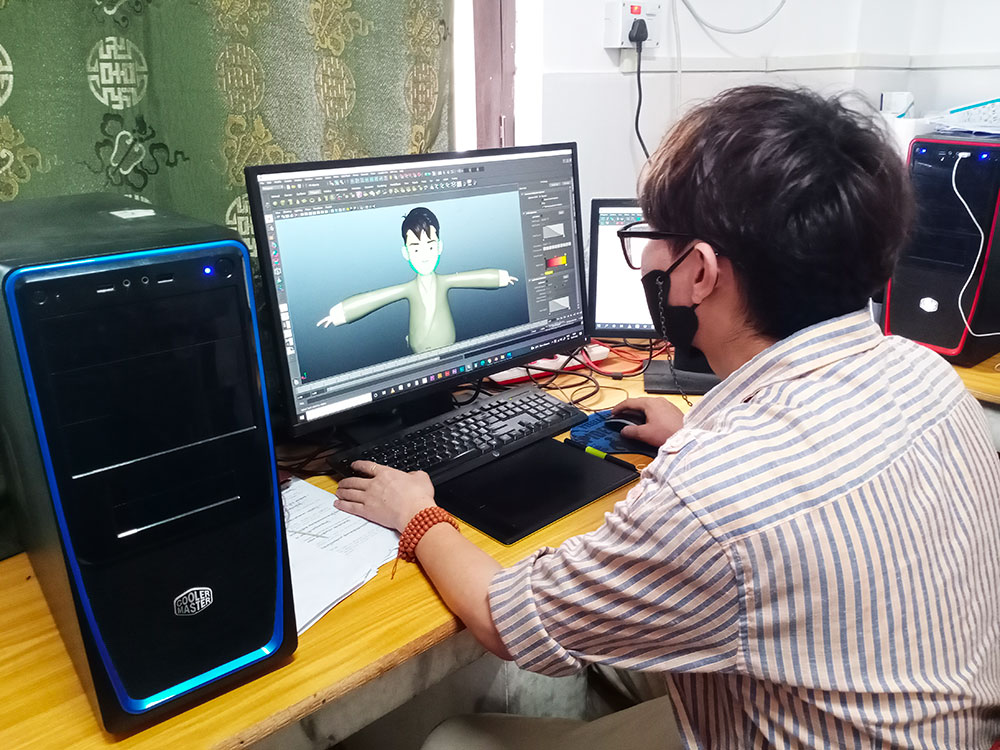Thinley Namgay
At the iBEST Institute in Thimphu, a 26-year-old animator, Tshering Yangki, sketches a girl on her computer. The character is part of the UNICEF and education ministry’s project.
For this project, the iBEST animation team will create an animation video to raise awareness on the importance of Early Childhood Care and Development.
Animation. Simply put means movement of picture. In a broader sense, it is an art of visual storytelling.
Tshering’s chamber is occupied with computers and youngsters who have come there to study animation. Everyone is working on creating different characters.

According to Tshering, the animation is a crucial form of ICT that can create employment. “Animation keeps changing depending on creativity.”
It requires more people.
A single animation video, for example, involves at least a 2-D animator, 3-D animator, content writer, background artist, illustrator, visual effects creator, compositor, and editor.
Tshering Yangki has been working at iBEST for almost six years.
“I had no knowledge of animation when I had just completed Class XII. I came to Thimphu to attend a month-long tally course. After that, a relative of mine asked if I would be interested to join iBEST to learn animation,” Tshering said.
iBEST alone has more than 30 animators, tell-tale sign of growing popularity of animation.
Druk Motion’s animator, Tandin Dorji, said that he started the firm in 2019 with a dream to improve animation quality in the country.
“I feel animation is the most effective way to communicate. It can change the perspective of how you see the world. It can bring out creativity. If you are passionate and want to tell a story, animation is the best platform,” he said.
Some of the animation firms in the capital are iBEST, Zoom Out, Yellow Box, Athang, and Druk Motion. These firms employ around 60 people in animation works.
And competition is stiff.
Nima, an animator, said that script, a character design, colour choice, storyboarding, and the background colour should be properly planned. It takes a lot of effort.”
Challenges
Pema Tashi is an animator. He said that animators face problems of meeting the demand of the client, deadline, and creativity issues.
“We also look at the best international animation works before proceeding with ours. I am optimistic that Bhutanese animators will do the work independently in the future,” he said.
For these firms, government agencies are the main clients.
Tandin Dorji said that it was sometimes difficult to get works. “The only customer we have right now is SAMUH.”
Another challenge is not getting enough time for production, according to Tandin. “There is lack of professional trainers in the country.”
Chief Executive Officer of Athang Private Limited, Karma Dhendup, said that his customers are government and international agencies, overseas companies, and a few IT professionals.
Competing with state-owned companies in ERP market he said, was changeling. “Because government owned agencies award them the work directly. Audience in Bhutan is small. To take it to the international level is costly and time-consuming.”
Sonam Wangdi, an animator at Yellow Box, said that resources are expensive. Animation needs a highly integrated computer.
The way forward
Karma Dhendup said that to reach global level, support from the government is necessary.
The animator at Zoom Out, Choling, said that Bhutan has a rich repertoire of stories and folktales which could be turned into animation programmes. “For that, the government can and must support animation firms and animators. Government can, for example, provide soft loans to animators to buy equipment.”
“Government can also provide free or cheaper space in incubation hubs.”
Sonam Wangdi, said that the government could provide advanced training to young and aspiring animators.
Many say that animation could be taught in schools to bring about significant development in the sector.
Edited by Jigme Wangchuk


